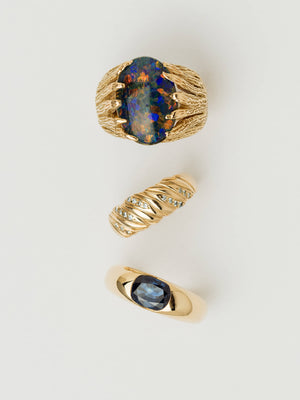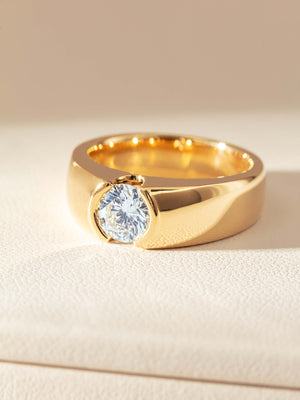If any silverware has the right to call itself the "crown jewels" of New Zealand, then it's probably The Bledisloe Cup - the trophy which epitomises the great rugby rivalry between New Zealand and Australia. So that pretty much makes Walker & Hall the country's crown jewellers!
The Walker & Hall name has been an integral part of New Zealand’s history for the best part of a century and a half. As far back as the late 19th century, newspapers carried adverts for shipments of the famed W&H-stamped cutlery, silver and plate from the firm’s Sheffield factory. By 1910 a reporter at Wellington’s Dominion newspaper was already urging customers to visit the company’s Featherston St store to see for themselves one of the leading brands of the British Empire.
“W. and H.” stares at you from every dining table, sideboard, and boudoir in every English-speaking country in the world, and the name is the synonym for quality and finish in every country coloured red on the map.
Walker & Hall made its name as the pioneer of electro-plated silverware after entrepreneur George Walker and Worcester solicitor Henry Hall joined forces in 1845 to create the first mass production plant to use the new technology from its Howard Street “Electro Works” in Sheffield.
In his autobiography Jack of All Trades: And His Family, Walker & Hall managing director (1956-1964) Peter Inchbald credited Sir John Bingham with turning the company into a leading light of the Empire.
The battlemented tower of Electro Works, topped with the triangular W & H flag, crowned the skyline opposite the Midland station and was the first landmark most visitors to Sheffield would see. [At the time of his death in 1915, Bingham] had fifteen British showrooms, with others in New Zealand and Australia and a strong presence at the Cape [South Africa].
Walker & Hall, then, was the obvious choice, for the newly appointed Governor-General Lord Bledisloe when he wanted to commission a new trophy to mark the fiercely contested international rugby contests between arch rivals Australia and the All Blacks.
Lord Bledisloe took up his office in Wellington on March 19, 1930, and less than a week later was already being reported as having taken up the role of patron of the Rugby Football Union. Newspaper clippings from throughout his five-year office repeatedly show him attending rugby matches and, despite the country reeling under the combined economic and social hits of The Great Depression and the 1931 Napier Earthquake, he went to great lengths to bolster spirits. As well as creating numerous “Bledisloe Cups” for competitions ranging from pig-rearing to photography, it was his decision to buy the 1000-acre property where the Treaty of Waitangi had been signed and he and Lady Bledisloe donated £500 to launch an appeal for its restoration.
The first mention in the press about rugby’s Bledisloe Cup was in the New Zealand Herald of September 12, 1931, under the heading “TROPHY FOR RUGBY”:
The Governor-General, Lord Bledisloe, has presented a cup for competition between the New Zealand and Australian Rugby teams and the first match for the trophy will be the test at Auckland tomorrow… The design of the cup will be decided upon later. It will be symbolical of both countries.
Clearly there was no physical trophy for the All Blacks to lift after they beat Australia 20-13 at Eden Park because Nelson Isaac, an Arts & Craft movement-trained jeweller, enameller and arts metalworker who was head of the art school at Wellington Technical College, had only just received the commission to design the trophy.
The Bledisloe Cup was intended to help cement the fierce rivalry between the two Southern Hemisphere countries after Australian rugby had spent much of the post-Great War period in the doldrums – especially outside Sydney.
The Herald went so far as to say New Zealand had helped rescue the game across The Ditch:
Rugby suffered greatly in Australia owing to the war, and after three tests were decided in 1914 it was not until 15 years later that Australia and New Zealand met again. It is well known that but for New Zealand’s assistance during this period the game would have practically died out in Australia.
At the time, the contest was named “the ashes” after the England v Australia test cricket rivalry, and New Zealand had suffered a 3-0 series clean sweep in 1929 before claiming that single test win in 1931. So the arrival of the new Walker & Hall-created silverware was much heralded ahead of the three-test winter series of 1932.
Unfortunately, though, when the All Blacks set sail on board the Marama bound for Sydney on June 17, the trophy was still 10 days away on board the Westmoreland and as Lord Bledisloe waved the team off with “cordial good wishes” he was also quoted as regretting “that you will just miss seeing the New Zealand-Australia football trophy, designed by a New Zealand artist and executed by British craftsmen”.
Once the Westmoreland had docked, though, The Bledisloe Cup was immediately displayed in the main window of Milne & Choyce department store – the wrong side of The Tasman to be at the matches, but perfect for the fans who flocked to see the huge trophy.
This is how The Press in Christchurch reported the arrival:
The cup is one of the most handsome presented in New Zealand. It is of sterling silver, and is surmounted by a silver Rugby football. The chasing on the lid is an interweaving of New Zealand fern and Australian gum nuts and leaves in high relief. Engraved on the front of the cup are the arms of New Zealand, the arms of Australia being on the reverse side. The chasing around the base is an intermingling of Australian wattle flowers and New Zealand kowhai flowers in relief. The height of the cup, irrespective of the plinth in 28in. It is 25in in width, and weighs 290oz. The substantial oak plinth is surrounded by 25 shields for the names of the winning country in each series of games. … The trophy was designed by Mr Nelson Isaac, head of the Art School of the Wellington Technical College and was made by Walker and Hall, Ltd.
But the Bledisloe Cup was still needed in Australia – after all, that’s where the players were and it would have to be presented at some stage. It’s interesting to note that had either side won both of the opening two matches to win the series, the trophy would not have been on hand to be awarded – however the “young and mostly inexperienced” All Blacks lost the opener 22-17 in Sydney but fought back in Brisbane a fortnight later to square the series with a 21-3 victory.
The decider was scheduled for Sydney Cricket Ground on July 23 and the 2pm edition of the Auckland Star on July 22 gleefully announced the silverware was there on time.
The Bledisloe Cup for competition between New Zealand and Australia at Rugby has arrived. It is now being exhibited in the window of the Dominion [New Zealand] Government’s office. Attracting great attention, the cup is much admired.
The All Blacks trounced Australia 21-13 in the decider (they’d been 21-5 up at one stage before a late rally) in a match described by the Aussie captain Syd Malcolm as “the best sporting game ever played” and the trophy was paraded around the field by the All Blacks manager William Wallace and president of New South Wales Rugby Union Harrie Wood, while the teams swapped jerseys, formed a circle in the middle of the pitch, linked arms and sang Auld Lang Syne!
The actual presentation of the cup was made a week later on July 29 at the New South Wales Rugby Union in Sydney shortly before the team set sail for Wellington aboard the Zealandia.
The squad’s return to New Zealand took place at No2 Queen’s Wharf in Wellington after their ship had docked at 7.30am and the players and management disembarked to a “warm reception” shortly before 9am and performed a haka on the quay.
Before they all went off to a celebrationary lunch with Lord and Lady Bledisloe at Government House, the trophy was handed over to the Rugby Union and the crowd got its first taste of seeing the New Zealand name inscribed on a shield.
This is how the Evening Post described the scenes:
The Bledisloe Cup, which must rank as one of the finest sports trophies in the Dominion, attracted much notice as it stood on a table outside the dining saloon, and was further admired when seen by the general public. Familiarly known as “the mug” the trophy is greatly valued by the team, but one could feel that the players had a stronger sense of satisfaction in that they had gone away, young and untried, badly beaten in their only game in New Zealand and had returned with the hard-won laurels of victory think upon them.
For those All Blacks fans unable to make it to the Wellington quay, newsreel footage of their great victory in Sydney was soon winging its way into cinemas across the land.
Just a day after the Bledisloe Cup arrived back in New Zealand for its first official spell of “ownership” by the New Zealand Rugby Union, advertisements for the latest romantic movie Letty Lynton – starring Joan Crawford and Robert Montgomery – carried the additional note that the programme would include footage of the final test “by which New Zealand won the Bledisloe Cup”.
DID YOU KNOW?
- The first Bledisloe Cup rugby match may well have been played in September 1931 at Eden Park but a month earlier, another Bledisloe Cup had been won by a New Zealander and was already being sent from London. Here’s the Ellesmere Guardian from August 7, 1931: “The silver challenge cup, presented by the Governor-General, Lord Bledisloe, to be competed for annually by New Zealand exhibitors of apples in all classes of the British Empire and Overseas Sections of the Imperial Fruit Show, held in London in June and October of each year. The cup, which has been awarded to Mr HE Stephens, of Woodstock, Stoke, Nelson, is now on its way to the Dominion.”
- Lord Bledisloe may well have thought his trophy had been “designed by a New Zealand artist and executed by British craftsmen” but craftsman Nelson Isaac, who came up with the design, was actually an Australian! He was born in Kyneton, Victoria, in 1893 before his family emigrated to Nelson in 1896.
- Lord Bledisloe was a keen rugby fan and was elected president of his local rugby club in Lydney, Gloucestershire, when he was just 20. He stayed president for the next 70 years until his death in 1958, aged 90.











